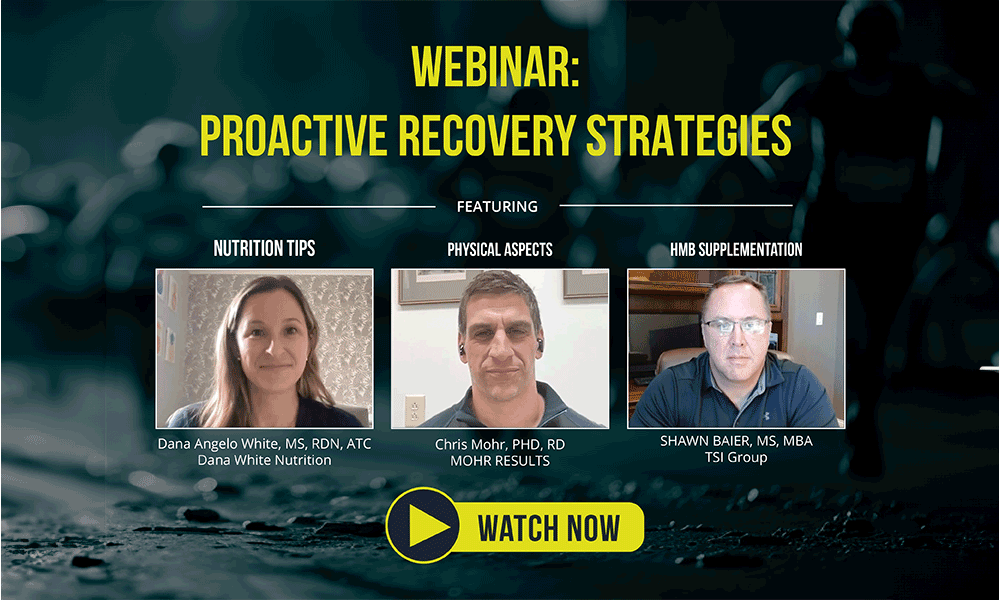Ready S.E.T. SLEEP EAT TRAIN – Recover
Are We Underemphasizing the Importance?
By Elyse Lovett, MBS, MS
Move Nutrition Editor
Exercise is a fundamental component of a healthy lifestyle and essential for achieving health and fitness goals. The benefits of exercise have been researched and widely acknowledged for centuries in athletic performance, weight management, and overall mental well-being. Recent research has linked the benefits of exercise to other health benefit areas such as cognitive, cardiovascular, immune health, and stress and mood support.
Optimal recovery after exercise or physical training is essential for enhanced performance, reduced injury risk, and to promoting long-term health benefits. Research has shown, time after time, that while the benefits of exercise are a cornerstone to health and fitness, the exertion and stress imposed on the body necessitate recovery strategies. These strategies include minimizing the risk of long-term adverse events. We take a deep dive into recovery after exercise, focusing on the physiological mechanisms of recovery, the strategies that have the most benefits post-exercise, and the implications of recovery for those with active lifestyles. Do we underestimate what it takes to fully recover and whether we have actually ever achieved that state?
The Importance of Muscle Recovery After Exercise
Adequate muscle recovery time allows the body to facilitate muscle repair and growth, replenish energy stores, and repair damaged tissues. Exercise triggers muscle protein synthesis (MPS) which is the metabolic process that describes amino acid incorporation into bound muscle protein over a given period of time. This highly regulated process, where the body repairs and builds muscle proteins, occurs in response to muscle damage, exercise, and dietary protein intake especially during resistance training or high-intensity workouts. This process leads to muscle growth strength gains and improved performance.
Muscle recovery also involves inflammation and immune response as well as blood flow and oxygen delivery for individuals to perform at their best. Exercise-induced muscle damage could lead to inflammation and the activation of the immune system. While acute inflammation after exercise is a natural part of the natural healing process, chronic inflammation can impede recovery. Adequate blood flow is essential for delivering nutrients and oxygen and removing waste products from muscles. This is vital for repair and growth during the recovery phase.
Since the repair process occurs during the recovery phase, particularly during sleep and rest, without sufficient recovery, muscle repair can be impeded leading to delayed progress or even overuse injuries. Sleep or the lack of sleep should be stressed as a contributing factor and plays an important role in the process of exercise or injury. Lack of sleep damages muscle physiology and impairs muscle recovery because of increased stimulation of protein degradation which is harmful to protein synthesis and promotes muscular atrophy.1,2. Adequate rest and recovery periods allow muscles to repair and grow ultimately leading to improved strength, endurance, and muscle size.
Maximizing performance capacity, especially performance in athletes, includes not only training but also depends on the optimal balance between training and recovery to prevent stresses induced by the intensity of the load3. Changes in muscle damage indicators such as creatine kinase (CK) and inflammatory biomarkers such as C-reactive protein (CRP) and interleukin-6 (IL-6) that are associated with delated onset muscle soreness (DOMS) can be used to achieve skeletal muscle recovery.4
The delayed onset of muscle soreness after an intense workout is a common experience that typically peaks 24-48 hours after a workout. As we know, it can be quite uncomfortable and makes simple tasks such as picking items off the floor or walking down a flight of stairs seem fully impossible. While soreness is a natural response to exercise-induced muscle damage, proper recovery measures can be put in place to reduce the severity and the duration of it. A 2018 meta-analysis looking specifically at DOMS found massage to be the most powerful procedure that induced benefits in DOMS and perceived fatigue. In addition, the use of compression garments and immersion induced a positive impact on some variables but with a less pronounced effect.5
Strategies for Post-Workout Recovery
Nutrition plays a key role in post-exercise recovery for muscle building and repair. Exercise-induced muscle damage (EIMD) is characterized by the microscopic damage/tissue changes and disruption of muscle fibers and surrounding structures that occur as the result of intense physical activity. EIMD is associated with several hallmark symptoms including DOMS and loss of muscle strength and function. This adaptive natural process leads to improved performance and muscle growth. The mechanisms, symptoms, and effective management strategies are essential for athletes, fitness enthusiasts, and healthcare professionals to optimize training outcomes, prevent injuries, and promote long-term exercise adherence.
Adequate protein intake post-exercise supports muscle protein synthesis and repair. Consuming a protein source containing essential amino acids, within a few hours of exercise or pre-exercise, is recommended for muscle growth and recovery. A 2020 randomized trial comparing pea, whey, and water supplementation on muscle damage, inflammation, DOMS and physical fitness showed that a high intake of whey protein for five days after intensive exercise mitigated the efflux of muscle damage biomarkers, with the intake of pea protein having an intermediate effect.6 Other studies have shown the development of lean mass, increased strength, and improved recovery are achieved through protein supplementation and can stimulate muscle recovery.
Carbohydrates replenish muscle glycogen stores providing energy for future workouts. Carbohydrate intake within the first few hours post-exercise is crucial after intense or prolonged exercise and for the restoration of muscle glycogen stores. Numerous studies have shown that carbohydrate supplementation may improve sports performance in certain physical activities depending on the intensity and duration of the activity. The 2017 stand on nutrient timing by the International Society of Sports Nutrition (ISSN) states that carbohydrate ingestion throughout resistance exercise has been shown to promote euglycemia and higher glycogen stores. In addition, consuming carbohydrates solely or in combination with protein during resistance exercise increases muscle glycogen stores, ameliorates muscle damage, and facilitates greater acute and chronic training adaptation.7
More recent studies showed the combination of carbohydrates and proteins is a good strategy to replenish glycogen and contributes to tissue repair. The combination of protein and carbohydrates after resistance exercise increases muscle protein synthesis more effectively than protein or carbohydrates alone. The carbohydrates help create an insulin response that aids in nutrient uptake by muscle cells.8
Proper hydration is an important component of recovery and performance and is essential for maintaining physiological homeostasis. Post-exercise recovery encompasses the restoration of fluid balance, energy stores, and tissue repair that relies heavily on adequate hydration. Dehydration post-exercise can have negative effects in recovery leading to deficits in exercise performance and thermoregulation.
Summary
Recovery is a critical part of post-exercise strategies for both individuals engaging in physical activity and athletes. Recovery promotes muscle protein synthesis allowing for the repair and growth of muscle tissue. Relishing glycogen stores, which are depleted post-exercise, is an important strategy in recovery to maintain energy levels. Reducing DOMS with massage, stretching, and proper rest can enhance readiness for future training sessions.
A fatigued athlete or person training without proper recovery methods will lead to suboptimal performance, reduced strength, and decreased endurance. We have explored well-researched recovery methods that play a pivotal role in optimizing physical performance and reducing injury risk. Post-exercise could become underemphasized because of the dynamic process that involves physiological, psychological, and nutrition components in adopting recovery strategies that suit individual needs. The role of recovery after exercise is not only a recommendation but a priority to those seeking their full-athletic performance. As we unlock more research in recovery in areas such as immune system support and hormonal balance, recovery strategies and methods will become more dynamic for those wanting to optimize their physical performance.
[6] Nieman D., Zwetsloot K., Simonson A., et al. Effect of Whey and Pea Protein Supplementation on Post-Eccentric Exercise Muscle Damage: A Randomized Trial. Nutrients. August 2020.
Subscribe for additional Move Nutrition Quarterly content like research updates, market insights, and more.

